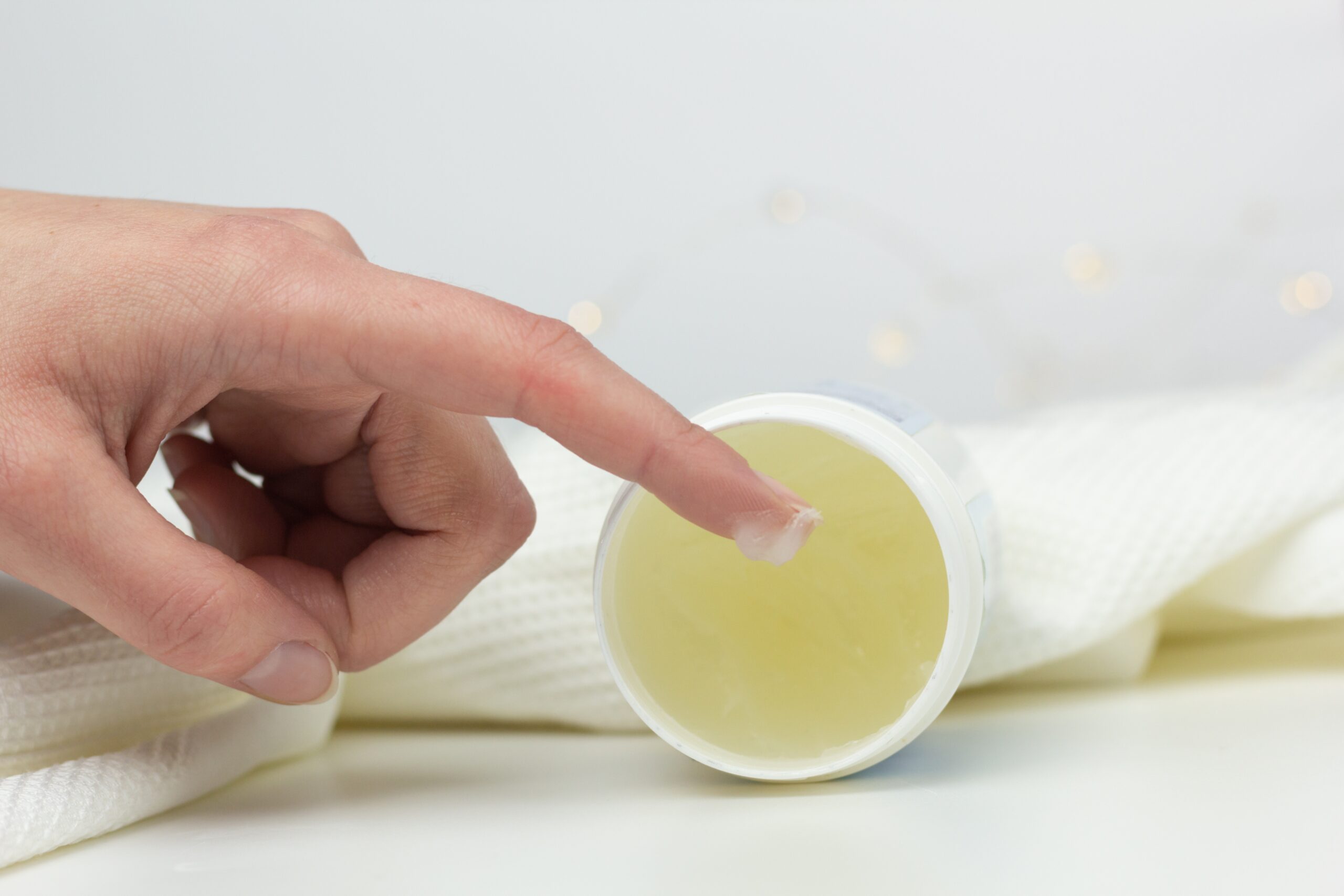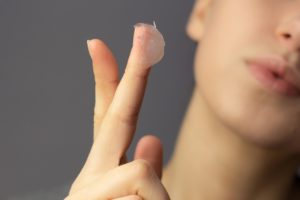

If you haven’t heard of “slugging” yet, then you probably don’t spend a lot of time on TikTok. This is the Tik Tok craze that is singing the praises of petroleum jelly as a facial moisturizer. Skin slugging may sound like a new beauty trend to try out. It seems to be taking social media by storm and you can find it recommended both by beauty bloggers and skin professionals. My sister first alerted me to it – and being always curious about skin care crazes – decided to do some research of my own.
Despite its name, skincare slugging has nothing to do with snail enzymes. It more refers to the look your face gets when you apply a thin layer of a petroleum-based product – shiny, gooey and slimy, as if a snail has left its trail all over it.
Skin slugging actually refers to using a highly occlusive petrolatum product (most often Vaseline, CeraVe Healing Ointment or Aquaphor Healing Ointment) as the last step of your nighttime skincare routine. And what occlusive products do is create a practically impenetrable protective layer on the top of your skin.
This layer supposedly reinforces your skin’s protective barrier. It is promoted to lock in all the moisture that would be lost during the night, keeping your skin hydrated, plump and supple. It can also somewhat increase the strength of the products you’ve applied underneath it.
However, petroleum jelly, commonly known by the most popular brand name Vaseline, is a derivative of oil refining. Originally found coating the bottom of oil rigs in the mid-1800s, it’s a byproduct of the oil industry and therefore an unsustainable resource (read: not eco-friendly). It’s commonly used topically to cure everything from dehydrated, flakey skin to diaper rash.
Though generally regarded as safe, the components that are removed from the oil during the refining process of petroleum jelly are carcinogenic in some cases. Vaseline supposedly has all of these components removed but there are probably plenty of petroleum jelly imitators, and one doesn’t always know the extent that they’re removed. Since petroleum jelly can be found in “different grades of purity,” you don’t always know how non-toxic your petroleum jelly-based beauty products really are. (For the record, Vaseline is highly-refined, triple-purified and regarded as non-carcinogenic.)
Your skin loves hydration, so anything that helps keep that water in is your skin’s new best friend. Well hydrated skin is plump, soft, smooth and youthful.
It is a difference that can help your skin to better deal with aging. But it is also something you can notice right away – in slightly less pronounced fine lines and a slightly brighter glow.
Unlike your regular moisturizer, petrolatum products are way more occlusive. That means that unlike your face cream, petroleum jelly can truly make sure all the water stays in your skin all night long.
However, these products don’t supply your skin with moisture. That is why using a petroleum product over a thinner hydrating product makes such a powerful combination. The hydrator gets the moisture to your skin, the occlusive makes sure it stays there.
Especially if you have dry, dehydrated or mature skin, you will love this technique. Many people get truly surprised by how velvety-smooth their skin starts to feel after a few days of slugging.
It feels better moisturized in the morning. It looks more hydrated the whole following day. You can say goodbye to the tight, itchy feeling and dull complexion.
Slugging also helps your skin heal faster. If your skin barrier is compromised because of the harsh winter weather or if you’ve over-exfoliated it, putting an occlusive layer over your other products at night can help your skin recover faster.
By slugging your skin, you help repair and reinforce the barrier’s functioning. Ultimately, that means less damage and a healthy, youthful skin for much longer.
The point of using petrolatum is to create a seal that will keep all the good stuff in your skin. Just keep in mind that these products will keep all the bad and irritating stuff in, too.
Start by cleansing your skin as well as you possibly can. Any trace of dirt, bacteria, sunscreen or makeup left will be trapped on your skin during the night. This doesn’t mean you should strip your skin or use harsh cleansers. Just make sure it’s really clean using a gentle chemical free oil cleanser that is right for your skin.
After the cleansing, the best step 2 would be a ton of hydration, to supply the skin with water that petrolatum can seal in later. You can supply that moisture by using a mist or a serum that contains humectants, such as hyaluronic acid, glycerin, honey or aloe vera.
Now, the third step of skincare slugging – it can be debated if it really is necessary or not. But I certainly like to add a thin layer of a nourishing face cream like 100 X Washed Ghee. My skin just feels better when I do.
The last step would be your occlusive. CeraVie, Vaseline or Aquaphor each have their fans, but any would work. Apply just a thin layer – a pea-size amount should be enough. And not everyone should apply an occlusive to a whole face – use it only in the areas that tend to get dry.
As with everything skincare related, slugging is not a one-size-fits-all solution. Though its benefits for certain skin types are undeniable, if your skin is not a good fit for it, it might do more harm than good.
This is because petroleum used for skincare slugging pretty much works by trapping everything that’s underneath it. And even though petrolatum itself doesn’t clog your pores, it will trap things that may clog them, such as sebum, dead skin cells and bacteria.
People suffering from skin conditions like acne and rosacea should stay away from petroleum jelly altogether, since such thick emollients can aggravate those conditions. Those who rub Vaseline on dry, cracked noses to get through a cold might want to think twice, too. The product is recommended for external use only, which doesn’t include nostrils. What’s more, a rare but scary potential problem occurs if the petroleum jelly moves from nostrils through the respiratory system. If petroleum jelly gets into the lungs, it can cause lipid pneumonia.
That is why face slugging is not recommended for people who have oily or acne prone skin. You may also want to avoid this technique if you sweat during the night. And make sure to double check all the products you use underneath your slugging layer and if any of them might be comedogenic.
Another thing to keep in mind – it might be better to skip slugging on the nights when you use your retinol or chemical exfoliators. As amazing as these products can be, they also have a potential to irritate the skin. And occlusives increase this risk by a lot.
It’s an inexpensive way for a formulator to offer the appearance and immediate feel of hydrated skin. That is why petroleum jelly crops up in our beauty products. As a mineral oil, it doesn’t actually moisturize, but it does a good job at holding in moisture — if you make sure to thoroughly wash and moisturize your skin before application, that is.
When you wash your skin with soap, you destroy some of the barrier and remove natural oils, so petroleum jelly can help repair that barrier if used properly. It’s like putting a piece of plastic over your skin — it prevents evaporation. But everyone is different, so it’s important to see how your skin reacts to Vaseline or any other petroleum jelly-based products before committing to a regimen.
The upside – it can be used in the winter when skin is dry and cracked sealing in moisture.
The down low – I would not do it as I like to put natural botanicals on my face and dislike any oil petroleum products that are not eco-friendly for my skincare.
Don’t think you have to forfeit the soothing feeling of Vaseline if you decide to not to use petroleum jelly, though. If you’re looking for a dewy moisturizer, just opt for more natural alternatives and check ingredients. Products containing beeswax, coconut oil, olive oil, shea butter and cocoa butter seal in moisture and don’t come with some of the risks of petroleum jelly. Remember that your skin care products are absorbed into the skin, so it’s nice to use something that you wouldn’t mind putting into your body.
I decided slugging was not for me!
If you are looking for skincare that is personalized for you based on your skin type, your dosha and the season you are in. If you like to avoid using harsh ingredients or oil derivatives – then check out our Vedaceuticals line.

The Holistic HIghway integrates traditional Western medical practices with Ayurveda medicine, creating a focus on prevention through nutrition, diet, and exercise; use of the latest genetic testing and other diagnostic techniques; and prescribed combinations of botanical medicines, supplements, therapeutic diets, detoxification programs, or stress-management techniques.

Integrative Health Expert | Ayurveda Practitioner | Author | Speaker
Kerry is a globally recognized leader in integrative medicine and the science of health known as Ayurveda. She is passionate about raising awareness of the need for a change in contemporary medicine that focuses on patient empowerment and a health-based (rather than disease-based) medical system.
Kerry is connected with The University of Pittsburgh Center for Integrative Medicine and remains a pioneer in the field of integrative medicine where she has developed a personalized system to manage chronic disorders by incorporating fundamental changes in diet, behavior, and stress while focusing on genetics.
This individualized program is so successful that many of her clients have achieved maximum healing and vitality after years of chronic problems!
More to Explore
Contact
Disclaimer
The sole purpose of all the website content is to educate and provide information about Integrative Health, Genetics and Ayurveda.This information is not intended for use in the diagnosis, treatment, cure. or prevention of any disease.
Stay Connected